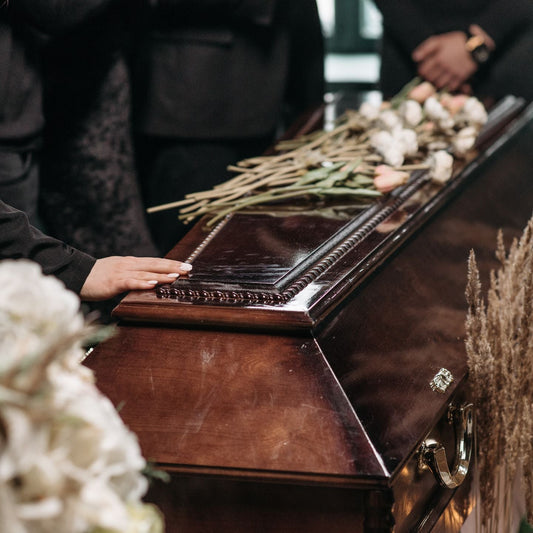
Why Do People Wear Black to Funerals?
Black is one of the most universally recognised colours associated with grief, loss, and remembrance. Across many cultures and centuries, it has stood as a symbol of mourning. The image of family and friends dressed in sombre black attire gathering to honour a loved one who has passed is both familiar and powerful. But have you ever stopped to wonder why black became the colour of choice for funerals? Is it simply tradition, or is there a deeper historical and cultural reasoning behind it?
The colour black evokes solemnity and seriousness. It communicates a mood of reflection and respect without the need for words. In modern Western culture, wearing black to a funeral is considered a way to show solidarity, empathy, and reverence. But the story doesn’t start and end there. The roots of this custom run deep through history, shaped by societal norms, religious beliefs, and psychological associations.
In this blog, we’ll explore the origins of wearing black at funerals, how the tradition evolved, variations across different cultures, and what black clothing symbolises in the context of mourning. We’ll also touch on how funeral etiquette has changed and what dressing for a funeral means today.
Historical Origins of Mourning Attire

The tradition of wearing black to funerals dates back to the Roman Empire. Romans would wear dark togas, often black or very dark grey, during mourning periods. This attire was not just a statement of grief but a public acknowledgement of loss, allowing others to offer their support and sympathy.
Later, in Europe, especially during the Middle Ages, black mourning clothing became more formalised among the aristocracy and royal families. Monarchs, nobles, and prominent figures would don black garments to mark periods of mourning, often accompanied by veils, gloves, and even black accessories like jewellery or fans. The death of a monarch or royal relative would often require courtiers to wear mourning clothes for extended periods, sometimes even up to a year.
The Victorian era, particularly under the reign of Queen Victoria herself, had an enormous influence on how mourning was publicly expressed. When Prince Albert died in 1861, Queen Victoria famously wore black for the remaining 40 years of her life. Her mourning rituals set a cultural standard. Elaborate rules were established about how long widows and family members should wear mourning black and when they could transition to half-mourning (often lavender or grey attire). For Victorian society, mourning was not only emotional but also ceremonial and highly codified.
The Symbolism of Black

Black has long been associated with mystery, the unknown, and the afterlife. It’s the colour of night, representing the end of a day—and symbolically, the end of life. In this way, wearing black becomes a visual metaphor for the passage from life to death.
Psychologically, black communicates seriousness and restraint. It discourages attention-seeking and promotes a unified, humble appearance. When attendees of a funeral dress in black, it’s often seen as a sign of respect towards the deceased and their family. It tells the grieving family, "I’m here, I’m sharing your sorrow, and I understand the gravity of your loss.
There’s also a practical side to the colour black. It's formal, versatile, and widely available. Unlike bright colours or patterns, which can be distracting or considered inappropriate, black allows the focus to remain on the person being honoured and the emotions being shared.
Cultural Perspectives on Mourning Colours
While black is dominant in Western funeral customs, it's not universal.
- In many Eastern cultures, white is the traditional colour of mourning. In countries like China, India, and Japan, white represents purity and spiritual cleansing, which aligns with their beliefs about the soul’s journey after death.
- In South Africa, red is sometimes worn to funerals, symbolising both mourning and the blood of life.
- In Thailand, widows traditionally wear purple in mourning.
- In parts of Latin America, black is common, but cultural customs can also include religious garments, specific jewellery, or even regional fabrics that represent heritage and ancestry.
What’s clear is that clothing and colour in funerals hold deep symbolic meaning and are influenced by cultural values about death and remembrance.
Modern Funeral Etiquette: Is Black Still Required?

In today's world, funeral attire has become more flexible, especially depending on the wishes of the deceased or their family. While black is still considered the most appropriate colour in many Western funerals, some families encourage guests to wear other colours that were meaningful to the departed, such as their favourite colour or something that reflects their personality or spirit.
Casual wear is generally discouraged unless otherwise specified, but there is a growing awareness that sincerity and respect matter more than strict dress codes. Nevertheless, when unsure, it’s always safe and thoughtful to wear subdued, darker colours. Black remains the go-to colour for those who want to express solidarity and avoid drawing attention to themselves.
If you're selecting an outfit for a funeral, especially in the United States, black is almost always an appropriate choice. A simple black dress, suit, or slacks and blouse paired with modest accessories strikes the right balance between respect and simplicity.
Choosing a Casket to Reflect Dignity and Respect

The choice of funeral attire is just one way people express reverence during times of loss. Another is the selection of the casket itself. Much like wearing black, choosing a dignified and elegant casket is a reflection of the care, love, and respect you have for the departed.
For instance, the Camelot Black Casket with White Interior offers a visually striking yet dignified choice. Its elegant black exterior reflects the tradition of mourning, while the contrasting white interior conveys peace and rest. This casket is not just a final resting place—it’s a powerful visual tribute.
Caskets, like funeral clothing, carry emotional weight. They can reflect the personality of the departed or the wishes of the family. Whether traditional or modern in design, a casket should offer comfort and communicate honour.
Why Tradition Still Matters
In a world that is rapidly modernising, some may question whether customs like wearing black to funerals still hold relevance. The answer lies in the role these rituals play in the grieving process.
Traditions provide structure in times of emotional chaos. They give people something familiar to hold onto, especially when everything else feels uncertain. Wearing black is one such tradition—it unites mourners visually, signals to others that one is grieving, and offers a quiet way to participate in the solemnity of the occasion.
It’s not just about fashion or conformity. It’s about collective empathy. In a room filled with mourners dressed in black, each blends into a shared sense of loss. The colour acts like a veil—not to hide emotions, but to create sacred space for them.
Final Thoughts
So, why do people wear black to funerals? Because it is a simple, powerful way to show respect, to honour the dead, and to offer silent support to the living. Black communicates what words often cannot—it tells the world we are grieving and that the moment is one of reverence and remembrance.
Whether you adhere strictly to tradition or choose a more personalised path, the act of dressing with intention at a funeral is never just about appearance. It’s a gesture of love, empathy, and community.
If you have any questions, you can contact us at (800) 950-4042 orinfo@trustedcaskets.com. We’re here to help you choose the right casket with care and compassion. Visit our website at Trusted Caskets to view our full range of caskets and start the process today.


